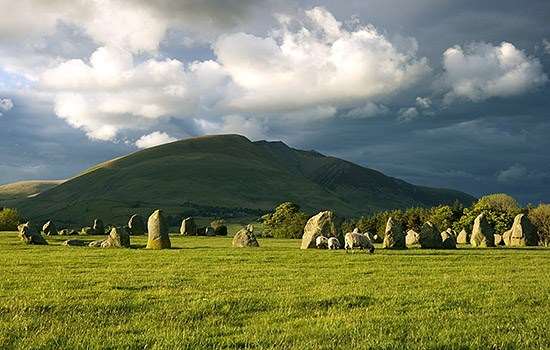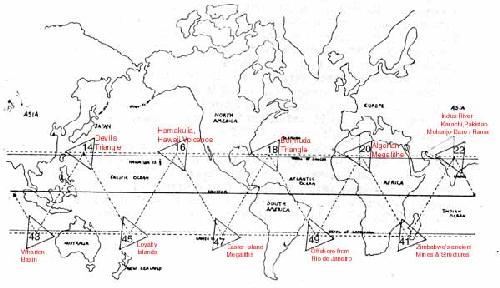In the 1920s, British researcher Alfred Watkins observed an intriguing pattern in various historical sites around the world: many of them appeared to be aligned in a linear fashion. He called this network “Ley lines,” suggesting that ancient pathways connected sacred sites and megalithic structures. Watkins, however, viewed these lines as simple transportation routes used by ancient peoples, without attributing any energetic or mystical properties to them.
Over the years, esoteric theories expanded this concept, associating Ley lines with invisible energy flows that would connect temples, pyramids, and ancient monuments, such as Stonehenge and the Egyptian pyramids. Some perspectives suggest that these alignments are not merely geographical coincidences but part of a global network of natural energy.
Despite the lack of scientific validation, various cultures have myths and beliefs about sacred paths and energetic connections. In China, these trajectories were called “dragon lines,” associated with Feng Shui and the circulation of Earth’s energy (Qi). Australian Aboriginals had “Songlines” or “Dreaming Tracks,” which, according to their tradition, were sacred trails mapped by their ancestors during the world’s creation.
Additionally, some theories suggest that Ley lines coincide with geological faults and areas of high electromagnetic activity, which could explain sensations reported by some people at these locations. In more speculative interpretations, it is even suggested that UFOs might be attracted to these areas due to their supposed energetic charge.

An intriguing theory suggests that Ley lines may emit different types of energy, influencing both the environment and the people around them. The website BudgetAir.com mentions:
“Think of the location of sacred sites around the world as being interconnected by these lines. These intersection points can be positive—spiraling upward in a clockwise direction—or negative—spiraling downward in a counterclockwise direction.”
Some esoteric theorists claim that a positive vortex occurs when Ley lines intersect at a 90-degree angle, creating locations associated with well-being, balance, and spiritual harmony. These points are believed to be ideal for meditation and healing.
On the other hand, a negative vortex could arise at intersections where energies are misaligned, supposedly resulting in harmful effects. It is believed that these areas may drain vital energy, affecting the mental, emotional, and even physical state of those exposed to them. However, these claims lack scientific support.
Connection to UFOs
Some researchers suggest that UFOs show an interest in Ley lines. Darren Perks, a British investigator, has proposed that these lines could serve as recharging points for extraterrestrial spacecraft, functioning as a kind of “energy grid.” He speculates that such vehicles may utilize electromagnetic energy and gyroscopic principles to power themselves and navigate using Earth’s magnetic fields.
Although there is no scientific evidence to support this hypothesis, numerous reports associate UFO sightings with locations near supposed Ley lines, adding to the mystery of this potential connection.
There are indications that UFOs may have an interest in Ley lines, sparking curiosity among researchers dedicated to the phenomenon. According to Darren Perks, these lines could function as recharging points for UFOs or extraterrestrial craft. He suggests that such visitors utilize electromagnetic energy and gyroscopes to power their vessels and navigate through Earth’s magnetic fields.
One possible example of a location associated with this theory is the Fold Mitchell Stone Circle. In addition to reports of UFO activity, the area is also known for mysterious cases of animal mutilation. It is believed that this stone circle was erected more than 3,000 years B.C., which, if confirmed, would make it even older than Stonehenge.

The relationship between Ley lines, unknown earth energies, and UFOs was first proposed by John Anthony Dunkin “Tony” Wedd (1919-1980). He developed this idea after reading the English translation of Lueurs sur les Soucoupes Volantes (MAME, 1954) by French researcher Aimé Michel (1919-1992). Michel introduced the concept of “orthotenies,” suggesting that UFO sighting locations in France during the 1954 wave followed patterns of alignment in straight lines.
Although Michel did not mention any connection to Alfred Watkins’ Ley lines, Wedd noticed a possible link between the two concepts. In his 1961 booklet Skyways and Landmarks, he proposed that UFOs might be using these lines for navigation. He also founded the organization The Star Fellowship, aiming to establish peaceful contact with UFO occupants. Among the members of the group was psychic Mary Long, who introduced the idea of “power lines” and “nodal points,” encouraging others to explore Ley lines.
Another account that may have influenced this theory came from Buck Nelson (1894-1982), who, in his book My Trip to Mars (1956), claimed to have been abducted by UFOs and taught that these crafts used Earth’s magnetic currents for propulsion. This led some researchers to suggest that Michel’s orthotenies and Nelson’s magnetic currents could be related to Watkins’ Ley lines.
Additionally, some ufologists point out that a significant number of UFO sightings and abduction reports occur near these lines. According to an article published in UFO Encounters magazine, a study on the so-called “Yorkshire Triangle” observed that paranormal activity and UFO sightings were more frequent in areas where the lines formed specific geometric patterns, such as an equilateral triangle. Some speculate that UFO activity might be drawn to these regions in a manner similar to how a magnet attracts metal.

The pyramids around the world, in addition to their imposing structures, present a fascinating mystery in their alignments, which seem to occur independently, without the builders having contact with each other. One of these mysteries lies in the fact that many of these pyramids are precisely aligned with specific astronomical points, such as stars, constellations, and the sun. This phenomenon raises the hypothesis that ancient cultures had a shared knowledge of the importance of the sky for the orientation and construction of their monuments. Furthermore, several of these pyramids are frequently located along Ley lines.
These pyramids were strategically aligned to connect to specific stars or constellations, such as Orion, the North Star, or the constellation of the Big Dipper. This advanced knowledge of astronomy by ancient civilizations suggests a deep connection with natural and cosmic phenomena. Here are some notable examples:
Pyramids of Giza (Egypt): The three main pyramids of Giza are aligned with the constellation of Orion. The Egyptians associated Osiris, the god of death and rebirth, with this constellation, and the alignment of the pyramids with Orion would have had a profound religious and spiritual significance. This alignment may also be related to the idea of “navigating” through the Earth’s energy lines, connecting the pyramids to invisible natural networks that cross the planet.
Pyramids of Teotihuacán (Mexico): The Pyramid of the Sun in Teotihuacán, Mexico, is aligned with the position of the sun during the spring equinox. This precise alignment demonstrates the advanced astronomical knowledge of the Mesoamerican peoples, who used these cosmic events as markers of time and cultural significance. The connection of the pyramids with the sun and the Earth reinforces the idea that these monuments were located along energy lines that connect important points on Earth.
Pyramids of Meroë (Sudan): The pyramids of Meroë in Sudan, associated with the ancient Kingdom of Kush, also feature alignments with stars and the sun. Although smaller than the Egyptian pyramids, these pyramids demonstrate the significant astrological knowledge of the ancient African peoples. This alignment suggests that the construction of pyramids and megalithic monuments was not a practice exclusive to one region but shared by various cultures around the world, all with a profound understanding of the heavens and natural forces.
Additionally, some pyramids may have been aligned according to universal geometric principles. These principles, found in various ancient cultures, were used to create perfect symmetry and establish a connection with the ideal proportions of the universe. The idea of “sacred geometry” is present in many of these civilizations and suggests that, in addition to astronomical alignments, there was a search for universal harmony through mathematical proportions.
This common practice of aligning pyramids with astronomical and energetic phenomena may be related to a deep understanding of the natural forces that govern the planet. The presence of pyramids and other megalithic monuments along these lines reinforces the possibility that the ancient builders were aware of the energies these lines could channel, perhaps using them to enhance the spiritual or energetic effects of their constructions.










